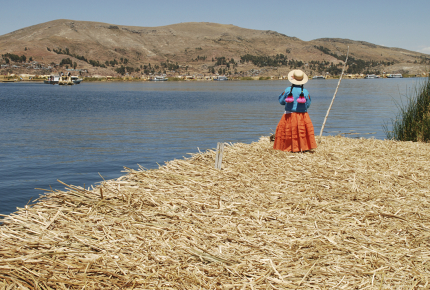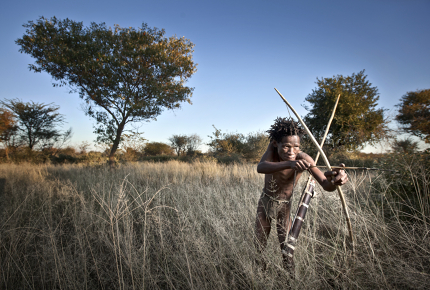Should we visit indigenous communities?
Visiting an indigenous community can offer an insight into local customs and cultures, but who is benefiting from ethno-tourism? And is it ethical? Daniel Fahey investigates.
I feel ashamed. I slump crimson next to a monk-haired German, silently pleading for our dragon-fashioned craft to pull away.
He smiles hopelessly, giggling through his thick moustache, before nudging me to join him as he stands and sways his palms from side to side toward the traditionally dressed Uru women singing Row Row Row Your Boat.
We’re on Lake Titicaca, around 5km (3 miles) from the Peruvian port of Puno, slowly drawing away from an island made entirely of Labrador-yellow totora reeds. Its entwined floor and its tiny woven homes are all made from the giant bulrush, as is its plaited lookout tower.
These manmade islands are home to the Uru people – a pre-Incan tribe that fled the mainland following persecution by the Incas and the Spanish.
As hunter-gatherers, the Uru earned the nickname Qhas Qut suñi (Men of the Water), rarely stepping ashore. Now they welcome tourists with nursery rhymes and reed-woven trinkets.
This is ethno-tourism in action (visiting a community to better understand the lifestyles of the locals) but frankly I find it uncomfortable.
“I think this is one of the problems that we have,” says Mark Watson, Executive Director at Tourism Concern, a charity that campaigns on ethical tourism issues. “Tourists want these authentic experiences because they see documentaries and they want to walk into the jungle and stumble across a little village that’s never had any contact.”
“But that’s quite difficult,” he adds. “So we need to think about how tourists engage with indigenous communities.”
 The Uru people live on manmade islands on Lake Titicaca
The Uru people live on manmade islands on Lake TiticacaKDickinson / Thinkstock
Currently less than 5% of the world’s population is indigenous, but they count for 15% of the planet’s most impoverished people. For them, tourism can play a major role in securing an income.
That’s why the Uru sell handicrafts in Peru and the Parara Peru dance for cash in Panama. It’s the reason the Mursi in Ethiopia charge tourists to take photographs of their lip plates (circular clay disks inserted into a pierced hole in their lip).
But with visiting the Mursi, there are deeper ethical questions. “The plates in their lips were part of their culture, but now it’s very much done for the tourists because it actually brings in an income,” says Watson. So has tourism prolonged the use of lip mutilation or preserved it?
That’s a topic for tourists to chew over, but Mark believes there are other indigenous communities turning these engagements and interactions into a positive force.
Take the Guarani in Brazil. They only allow tourists to visit once a month, setting up a little shop to sell some beads and trinkets. The rest of the time they continue with their lives as usual.
“The Guarani have just opened up to welcoming tourists,” he says. “What they do is put on a show, as it were, for the tourists. So the kids get out of their T-shirts and put on more traditional wear and they’ll do a bit of a show based on their culture.
“Indigenous Indians in Brazil were quite discriminated against and they were considered lazy, so part of it was a PR exercise for the people in the community,” he continues.
Financial benefits and stigma dispelling are just some of the positives tourism can bring. It also reduces the chance of land encroachment, which is often one of the biggest problems indigenous communities face.
 The Guarani in Brazil only allow tourists to visit once a month
The Guarani in Brazil only allow tourists to visit once a monthRodReis / Thinkstock
However, tourism can have its downsides as well.
Back in 2012, the Guardian newspaper discovered a number of unprincipled tour operators that were offering the chance to see the Mashco-Piro, a Peruvian tribe with very little contact in the outside world. This followed news that police on India's Andaman Islands were doing the same with the Jarawa community.
According to Survival, an organisation that fights for tribal peoples’ rights, illegal logging and oil and gas projects were pushing the Mashco-Piro out from the forest, giving these operators a greater chance of spotting them.
“Tourists shouldn't ‘visit’ tribes like the Mashco-Piro in Peru or the Jarawa on India's Andaman Islands because of the threats this poses to their health, and because the tribes haven't given their consent to such visits,” says Alice Bayer from Survival.
“Tourists cross through these tribes' land to ogle at them like animals in a zoo, or worse, to give them food, drink or clothes, exposing them to diseases to which they have little or no immunity,” she adds. “The outbreak of an epidemic could wipe them out.”
Illnesses that the modern world sees as treatable, such as influenza and chicken pox, have been known to kill up to 50% of an un-contacted tribe.
However, contact coughs up plenty of other issues too. The most extreme cases have included genocidal violence, slavery, racism as well as the theft of lands and resources.
“Since Survival exposed the ‘human safaris’ to the Jarawa tribe on India's Andaman Islands, the authorities have cracked down on tourists taking photos of the Jarawa, and handing out food to the tribes members,” says Alice. “They have also announced the construction of an alternative sea route around the Jarawa reserve, but progress on this has been woefully slow.”
Survival has called for a tourism boycott of the Andaman Islands until an alternative route is in place.
Things have progressed quicker in Peru: the government has ratified a supreme decree which says there should be no contact against the tribes' wishes and outlines what people should do if accidental contact occurs. They have also set up guard posts to prevent tourists from stopping near where the Mashco-Piro have been spotted.
 A woman from the Kayan community in Burma
A woman from the Kayan community in BurmaTS-Rolf_52 / Thinkstock
Although interactions with un-contacted indigenous communities have proved a cyclic barbaric tragedy, one has played out with increased wolfish vigour since the 18th century, they still happen. Tourists should avoid visiting un-contacted communities at all costs.
So how can tourists get a positive experience from visiting an indigenous community?
“We do need to think how we engage with indigenous communities and what we’re trying to get out of that,” believes Mark Watson. “Are we just looking for another experience or are we genuinely interested in how they live?”
As well as shows, Watson suggests communities give talks on the challenges they face in keeping a traditional lifestyle in a modern world. They could even offer workshops like the San in Namibia who teach tourists how to make traps and jewellery in the traditional way.
That’s because these communities are evolving as well, many embracing mobile phones, satellite TVs and modern clothes.
“You don’t want indigenous communities not to develop or progress because a tourist wants to have a Disney-fied version of them,” says Watson. “You don’t want the whole of Scotland just wearing kilts because some tourists might be turning up there.”
So in short, tourism can be beneficial for indigenous communities, ethical too, but it’s all about selecting the correct tour.
In that respect, the Uru community of the floating islands of Lake Titicaca tick the right boxes. They are progressing too: men sit in Western clothes and TVs buzz in the background; the women sing and dance and sell souvenirs for a little extra money.
As the German dances, I turn a mini, reed-woven dragon boat around in my hands, one I’ve just bought from an Uru craftsman. When it comes to indigenous communities it is best to handle with care.
 The San in Namibia teach tourists traditional skills
The San in Namibia teach tourists traditional skills2630ben / Thinkstock
Enjoyed this? You may also like:
Top 5 ethical trips to indigenous communities
12 ethical experiences for 2015
Do you have any Feedback about this page?
© 2026 Columbus Travel Media Ltd. All rights reserved. No part of this site may be reproduced without our written permission, click here for information on Columbus Content Solutions.









 You know where
You know where